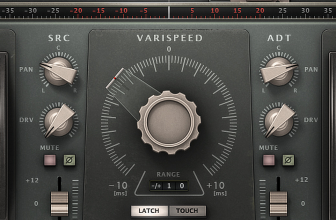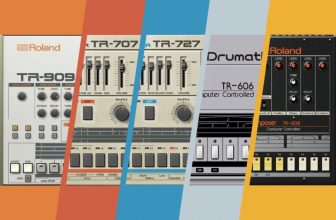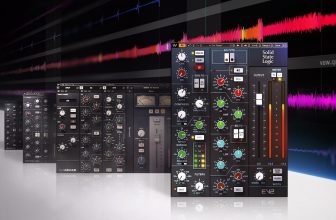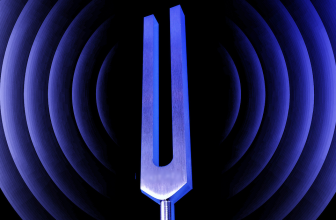
Headphones are a practical monitoring alternative to loudspeakers, but can you accurately mix on them with results you can trust to translate? Read our guide to solving headphone issues with headphone monitoring plugins.
Headphones are relatively affordable, compact and portable, making for a convenient monitoring system for productions, recordings and mixes wherever you are.
But are headphones sonically reliable enough for making serious mix and production decisions? Can you still make confident sonic choices that will translate across other listening mediums, or are you forced to stick with a trusty pair of studio monitors?
Mixes done on headphones are notoriously difficult to get right. In this guide we look at the issues they introduce, and how headphone monitoring plugins such as Nx Germano, CLA Nx, Nx Ocean Way Nashville and Abbey Road Studio 3 can help solve these issues.
Alternative to Speakers
Using headphones tends to come up in conversation as a “nice alternative” to working on studio monitors. But people only seem to “settle” for mixing on headphones when the favorable option of working on a stereo set of speakers is unavailable. This may be due to travel, bad room acoustics, disrupting neighbors, the list goes on. The truth is, headphones are not a natural listening experience to us as humans. Space and environment are crucial to the way that we hear sound and the way that our ears perceive frequencies, so it’s no surprise that most people prefer to listen and work on a nice pair of speakers.
Despite all their shortcomings, headphones are undoubtedly a necessity in modern music production, mixing and even mastering. Whether it’s a quick deadline, a sudden burst of inspiration, or unfamiliar/unreliable speaker monitoring environment, it is almost guaranteed that you will be relying on headphones at some point to make crucial sonic decisions.
In light of this, headphone monitoring plugins can be a healthy solution. By using psychoacoustics technology, plugins such as CLA Nx and Nx Ocean Way Nashville add a 3D audio experience to headphones, allowing them to sound and react like a pair of speakers set up in a real, acoustically excellent mix room. The result feels natural and realistic and solves many of the issues that plague mixes done on headphones.
We’ll go through some of the critical differences of headphone vs. loudspeaker monitoring and see how these plugins can provide a solution.
Space
Because of headphones’ close proximity to our ears, space is the most identifiable difference between them and speakers. The loss of that physical space and time also removes all of the natural room reflections that we are used to hearing along with the source, drastically altering the way we hear the audio.
Sure enough, the most immediate and noticeable difference that a plugin like CLA Nx or Nx Ocean Way Nashville provides is the sense of space. The perceived space becomes much deeper and more tangible. The music is no longer being directed immediately into your eardrums, but now feels more open, roomy, and diffused before being heard. The experience is very similar to the way you would perceive audio coming from speakers, which are typically a few feet in front of you. This change, while slightly strange at first, is almost immediately more pleasant sonically to listen to, and a far more realistic working environment. It also creates a better environment for you to decide how much reverb to use on your tracks. With natural room reflections accounted for, you are less likely to overuse reverb the way you would on headphones without the plugin on.
Stereo Image
A related spatial issue which particularly affects mix decisions is the difference in the stereo image between headphones and loudspeakers.
Stereo imaging has always been one of the biggest issues with headphones. In headphones, the left and right channels go directly to your left and right ears, separately, without ‘crosstalk’ between the two channels. On headphones, you always feel that things are either hard-panned left or right, and anything in between is just some smeared form of center. Working on speakers gives a much more tangible sense of stereo space and of where elements live left-to-right in a mix. This can also play a serious role when placing reverbs and delays in a busy mix.
Plugins like CLA Nx and Nx Ocean Way Nashville change that. The phantom center is up-front, audible, and things wrap around from left to right in a much more pleasing and realistic way than on normal headphones. Placing and manipulating a lead vocal is a breeze. Reverbs and delays are not quite as hyped and audible as they normally are on headphones, but they exist in a much more natural way which translates significantly better once on speakers. While the overall stereo width does feel narrower than that of normal headphones, it is also more on par with a traditional speaker set up.
This natural stereo image solution provided by Waves Nx plugins is probably the most critical factor in achieving mixes which translate better in other environments. Without it, mixing on headphones can feel like guessing.
Ear Fatigue
One of the biggest challenges and dangers of working on headphones is the ear fatigue that tends to set in more rapidly than in most other working environments. Sound sent directly into your eardrums, at any volume, is not ideal for your hearing, and with traditional headphone use, it is good practice to take frequent breaks and keep the volume low.
While Nx plugins like CLA Nx, Nx Ocean Way or Abbey Road Studio 3 do still require you to wear headphones, and sound is still technically being directed into your ears, the experience feels a lot less fatiguing and tiresome. The binaural “space” that is created cuts down the hard, upfront and direct nature of the sound of headphones. While the transient information is still present and perceivable, the modeled room allows the sound to “breathe,” resulting in a listening experience that feels like it would take much longer before ear fatigue started to set it. Obviously, it is still recommended to take frequent breaks to stay fresh and maintain a clear perspective, but the result is a much more pleasant mixing experience.
The additional, optional but recommended Nx head tracker tool helps significantly in creating a feeling of realism and combating the fatiguing characteristics of headphones. Because the head tracker captures in real-time your head movement in space, adapting the frequency spectrum in relation to your proximity to the virtual speakers, the sound is constantly shifting slightly. This provides the exact feeling of sitting in front of the speakers with your head bopping and moving along to the music.
Again, this opposes the feeling of a constant, direct and clinical sound that headphones seem to produce. Moving back and forth from the center sweet spot gives a fresh perspective that has always served as an advantage when working.
Frequency Spectrum and Low End
Getting a favorable representation of the frequency spectrum is not easy in any listening environment, but headphones make it even harder. Our ears perceive frequencies with different intensities at different volumes (see the Fletcher-Munson curve), so injecting those frequencies directly into your ears makes for a very different listening experience than on speakers.
This is especially true for low-end frequencies, whose physical wavelengths are incredibly long and require time to build up and mature to be perceived correctly. Low-end energy is generally “felt” through the vibration of your ribcage, rather than “heard.” Because headphones have very little (if any) physical space and air to let lower frequencies build up, they rely on the proximity effect and closeness to your ear in order to “fake” the perceived volume of the low end.
Thanks to the space provided by plugins like Nx Ocean Way Nashville, the perceived frequency spectrum is much more believable and realistic. The low end feels like it has had time to build and breathe and the top end no longer feels direct and clinical. Making EQ moves feels a lot more trustworthy, as if you’re EQing based on the source sounds rather than the unpleasant artifacts of the headphones’ sonic reproduction.
Consistency
One key benefit of headphones, that even some professionally treated studio monitoring environments cannot provide, is the consistency of what headphones can deliver. Even the most well-designed and maintained rooms will be subject to factors such as something physically changing in the room, or someone bumping your speaker a few inches. Because headphones are a fixed listening source that is attached directly to your ears, you’re able to remove any variables that could change the listening experience day-to-day. With Nx plugins, you get the best of both worlds: a consistent listening environment, without the pitfalls of headphone listening.
Conclusion
The intention of Waves Nx plugins is not for you to sell your speakers or put aside your aspirations for a professionally treated studio. However, these plugins bring significant benefits for referencing, and practical advantages that will greatly assist many contemporary producers and mixers. With headphones catering to people’s busy lifestyles with the advantage of portability and ease of use, tools like this plugin, which turn working on headphones into a much more trustworthy environment, will start to open the professional market to many more producers.
Want to get more tips straight to your inbox? Subscribe to our newsletter here.
creditSource link








